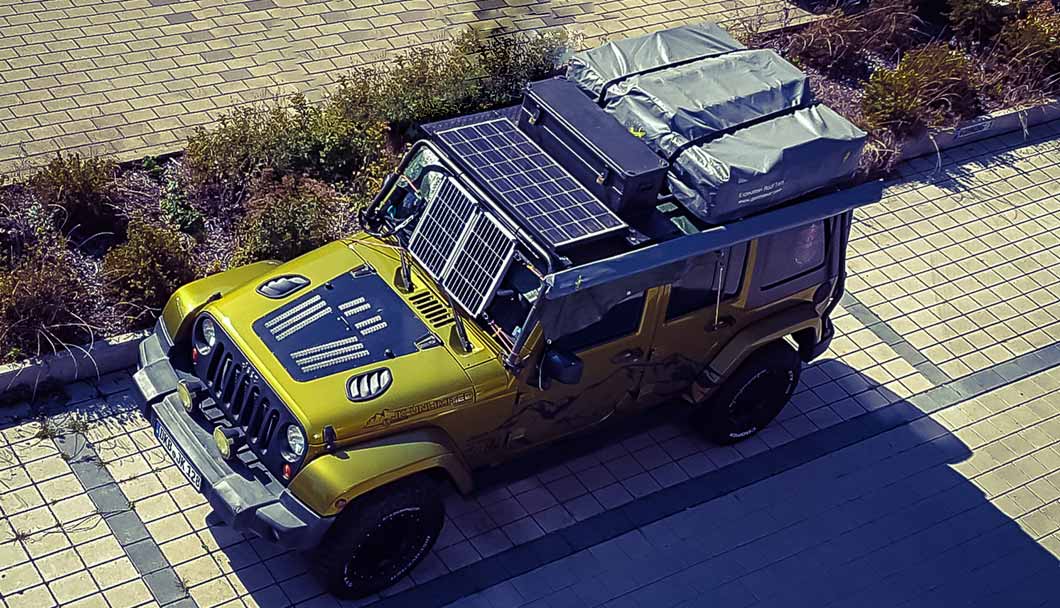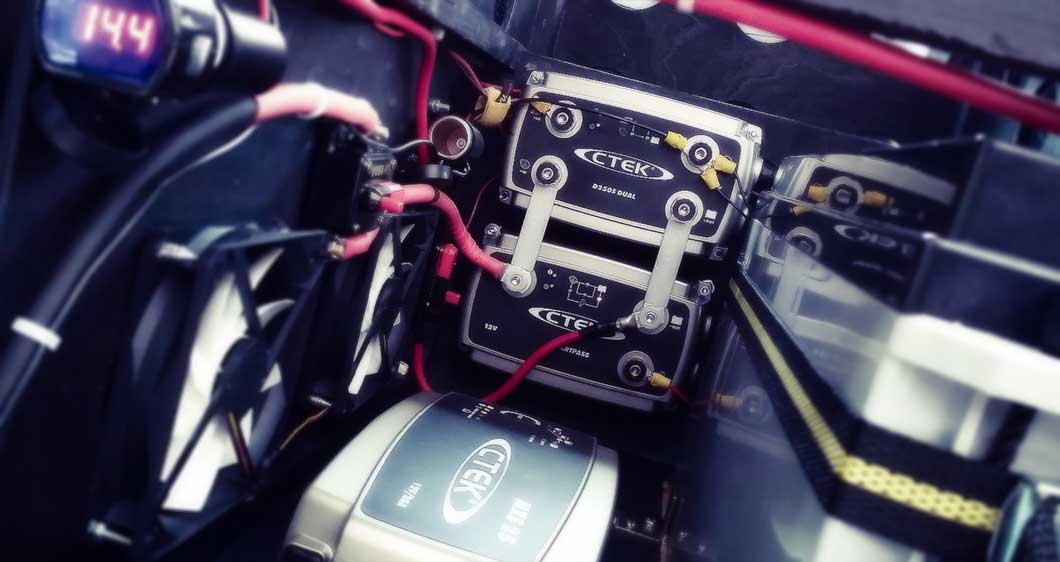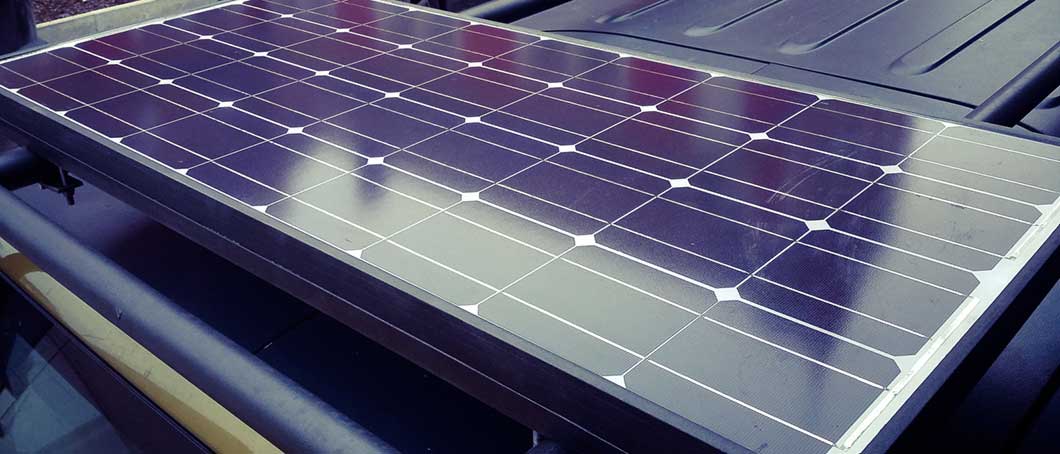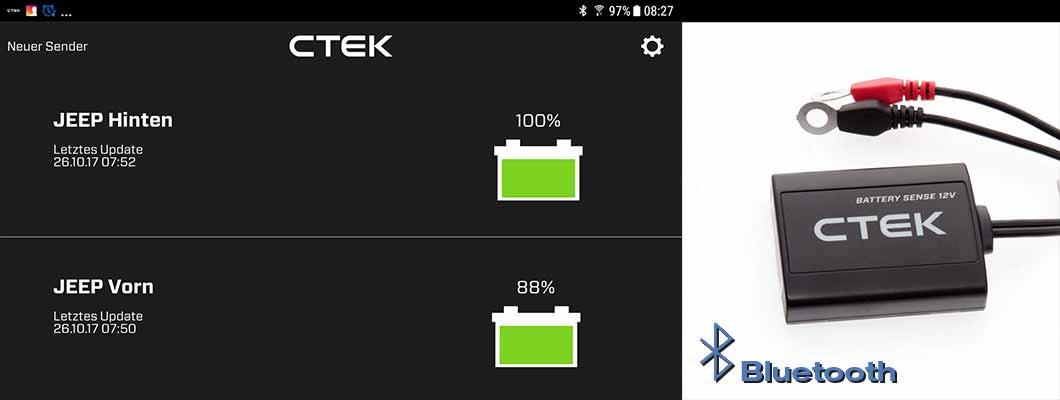JEEP - 4th STEP - DUAL BATTERY & SOLAR

Dual Battery & Solar System With 225 Amps And 260 Watt Solar Power
Due to our high demands on eletrical power, we needed something more intelligent than a simple cut-off relay and a service-battery. For our eletrical devices, like battery-chargers, power-banks, headlamps etc., we needed something more reliable, which wouldn't force us to stay on a camp-site.
A cut-off relay has a big disadvantage:
It usually loads the service-battery only, when the starter battery is fully charged. But what, if our soundsystem is running, the headlamps are turned on and maybe the air-condition or the heater is running? In this case, the service-battery practically would never be charged.
There might be some more intelligent cut-off relays for dual battery systems on the market, but I also thought about some more power suppliers, like solar energy or something else. I also wanted the dual battery setup to be charged parallel, as well as to boost the power, which comes from the alternator.
In this case I would have needed different devices:
. Cut-off relay
. Charge-controller (for the solar panel)
. Power-booster
. 230V Charger
But this system still would first charge the main battery and when it is fully charged, the service-battery afterwards.

Dual-Battery System - CTEK D250S Dual
The All-In-One Solution
The starter battery of the JEEP is a Optima Yellow with 75 Amps, which is a pretty good and reliable one, but it hasn't enough power for supplying all of our devices.
I still had an Effekta BTL 12-150, which I used in my VW T4. It is a deep cycle AGM battery with 150 AH and can be discharged until 8.4 Volts (if I remember right). Perfect for a proper dual battery setup.
After doing a lot of research, I found a system which could pretty much fit my needs.
Rather than buying 3 different devices, I decided to use one device that should manage everything.
CTEK D250S
The CTEK D250S is a Premium Battery Isolator, a Smart Power Relay and a Solar Panel Voltage Controller. It also contains MPPT solar power management functionality and a temperature compensated 20A smart battery charger.
All combined into one multi-functional product!
The D250S DUAL on-board charger, charges while you drive. It gathers energy from multiple DC power sources (the alternator(s), solar panels and/or wind power generators) and optimizes power to properly charge your service battery bank with microprocessor controlled smart charging algorithms.
It provides temperature controlled charging to meet the charge requirements of your service battery bank in any weather. It increases simplicity and reliability by eliminating the clutter of many individual components including battery switches, secondary battery isolators, relays, load managers, low voltage alarms and cutoff’s, separate solar panel and wind generator voltage controllers, etc.
(source: CTEK)

CTEK D250S Dual, CTEK Smartpass, CTEK MXS 25
With the system above, we already had a highly reliable power-management, but to make it even better, we also decided for getting the enhancement.
CTEK Smartpass
SMARTPASS is a smart automatic dual battery isolator switch and energy management unit. It controls and optimizes energy produced by alternators, solar cells, wind power or conventional AC/DC chargers. It distributes power to battery banks or consumers depending on energy needs, such as the service battery bank, bow thruster or anchor chain hoist batteries or power consumers like refrigerators, radio’s, etc.
Used together with a D250S DUAL DC/DC on-board Battery Charger, SMARTPASS provides optimal charging via CTEK’s unique multi stage charging cycle, which also protects your batteries. SMARTPASS also has an integrated “Battery Watch” feature which protects batteries from harmful total discharge and ensures that critical equipment such as radio, emergency lights and navigation systems get the proper priority to provide maximum functionality. SMARTPASS has a temperature sensor which protects batteries against high temperatures.
(source: CTEK)
On top of that, we've got the CTEK MXS25, a 25ah battery charger, in case we would stay on a campground with 230V electricity.

100 W Solar Panel, Mounted On The Roof Rack
225 Amps Of Battery Power & 360W Solar Energy
Now with our dual battery system up and running, we also added a 100W solar panel on the roof rack. The connection has been pretty easy. Without the need of a MPPT solar charger, we just plugged it into the D250S Dual and the solar panel worked from the beginning.
LED indicators on both devices always giving feedback of the current status, either if an error occurs, or the system is in standby or when it's charging the batteries.
And as everything has been so easy to connect, we furthermore added two 100W foldable solarpanels from Aukey and Polaroid and small solar suitcase of 60W. The problem with the roof top solar panel is, that its direction cannot really be changed. But for getting the most out of a panel, it's necessary to rotate it with the sun.
The foldable CIGS modules just weigh under 5KG each and the 60W suitcase is also a lightweight of under 8 KGs. All of them can be placed anywhere around the car. Their cables are r.a. 5 meters long and are equipped with water restistant MC4 as well as Anderson plugs.
All in all we now have a very strong power managed dual battery system with 225 Amps of battery power as well as a solar system with 360W. Under the very best circumstances it should bring approx. 23,2 Ampere per hour, when we're not driving, enough for all our batteries and electrical devices.
60 Watt Solar Suitcase
CTEK Wiring, Setup, Tips
Setting up the CTEK system is not that easy if you are a beginner. All devices come with a manual, but as always ... maybe it looks great, feels great ... but is a big crap;)
Dealing with electricity requires a lot of care and attention, especially in a system like this, where you have to deal with many different currents. I had to learn it the hard way by buying the wrong cables and fuses.
TIP # 1: Always use suitable fuses
Every single consumer should be protected, either with a separate fuse or via a fuse box.
Examples:
A refrigerator with a power of 45W, requires 3.75A (W / V = A). So you should use a 5A fuse.
A 30A fuse should be used to connect the starter battery to the CTEK D250S as the CTEK generates a 20A charge current. In conjunction with the Smartpass, it may like to be a 120A fuse, as this device generates additional 80A charging current.
TIP # 2: Use big cables
The manual isn't clear and precise. They are talking about much too thin cables.
For instance they would use a 6qmm cable for a 5m long connection between the alternator/starter battery and the CTEK. In this case, you will lose lots of amperes at the end of the line (powerloss by resistance)
For this connections the cable cannot big enough, so I've used a 25qmm cable.
Tip # 3: The devices are not reverse-polarity protected
"Red" is "PLUS" and "Black" is "Minus" or "Ground"
Always keep that in mind, otherwise you could damage the system!
TIP # 4: Make A Plan Before You Start
. Write down all your electrical devices (for the fuses, fusebox and the needed electricity)
. Properly measure the cable length (as short as possible, as long as needed)
. Label your cables
. Do not buy the cheapest products and choose your connections wisely (life's short 😉 )
. If you're driving a lot of offroad, think about how to make the system shock-resistant.
. If you're driving through water, think about water resistance and/or heightleveling
. Plan also the expandability
CLICK FOR THE BIG PICTURE
The wiring above is the exact same as in my car and double checked by CTEK, but you are the architect of your own fortune, so be careful. I won't take any responsibility for any resulting damage.
CTEK Battery Sense
Once you're done and the system is up and running, you may want to check the voltages and temperatures of both batteries from time to time.
For this case I'm using the CTEK Battery Sense Bluetooth module.
It works pretty well with Android, but sometimes you should restart your smartphone, otherwise it may be, that the values aren't updated properly.
There are other systems available, which are a bit cheaper, but as I wanted to have everything from only one brand, I've decided for the Battery Sense.
For making the temperature read possible, you need to connect the temp-sensors of both devices and place them very close to each battery.
The modules itself (one module for one battery) are connected to each battery. Once you've made the connection, you'll always get updated what's up with your batteries and if you're running out of power.
By the way: If you're running on low power and connected several devices to the CTEK Smartpass, it'll detect the low voltage and shuts down all devices (apart from the ones, you've directly connected to the batteries)
CTEK Battery Sense - Android App And Bluetooth Module
Final Conclusion & Personal Opinion
In all our cars we ran in trouble, when it came to power consumption. We never had enough of it. The cut-off relays didn't work very well and the one or other battery always ran out of power. Either we had problems with starting the car or our food got spoiled.
With the CTEK-System (which we're using since 2 years now) all problems are gone. While driving, the system charges all batteries with full force (and much faster than with only the alternator) and the solar panels are supporting the process.
I don't know really, how this system works exactly, but it works perfectly, even if some fiddling has been necessary to connect all the stuff. Main problem has been the manuals for these devices. CTEK speaks about very thin cables and in the first weeks I was wondering, why the system didn't charge properly.
I either had to change the fuses or the cables, as my cables have been much too thin. On the other side it hasn't been explained very well, where to get the ground connection from, so it took some time to get it all working.
Nevertheless I can fully recommend the CTEK devices. They are very well built, of TOP notch quality and worth their high price.
The solar panels are doing a great job too and granting us a self-sufficient time without any need of external power.
100 Watt Foldable CIGS Solar Suitcase
Here you'll get an overview, of what we're charging/supplying over the day:
. WAECO Mobicool Q40 (45W, 3.75AH, 24hrs, non-stop)
. 3 DJI batteries (2 times, à 10AH, 120min overall)
. 16 digital camera batteries (8hrs)
. 18A Dino Powerbank (trickle charge, 4hrs)
. 40A USB Powerbank (trickle charge, 2hrs)
. several AAA batteries for headlamps, tooth brushes, torch lights etc
. Shureflo Junior waterpump (not worth mentioning )
. JBL Charge 2 Plus (bluetooth speakers, 3hrs)
. JEEP Stereo-System (2hrs)
. Samsung Note 3 (8hrs)
. iPhone 4 (3 hrs)
. Samsung Galaxy S2 Tab (2hrs)
. Asus Zenbook UX3410UQ, 14" Notebook (2hrs)

100 Watt Foldable CIGS Solar By Polaroid
Feel free to ask me any question about the system. I may help, where I can.
Below you'll find all the manuals and factsheets for downloading.
Happy tinkering 🙂
GERMAN MANUALS AND SHEETS
(All rights reserved © CTEK 2016)
ENGLISH MANUALS AND SHEETS
(All rights reserved © CTEK 2016)






Hi!
Thank you so much for a really good description of your charging system. I live in a sailboat, and want to upgrade my electrical system. I`m thinking of using both solar panel and wind generator, together with the alternator generator from the engine. My question is: Is it possible to connect all these three generators to the CTEK system? If so, do you connect wind and solar to the same connection, and then the alternator by itself?
Thank you for your time 🙂
Best regards
David
Hi David.
Thanks and sorry for my late reply, but we recently came back from Costa Rica. Of course you can use wind generators as well as solar panels and alternators together with the CTEK. Please take a look into the manuals (links on my blog) for further information. A great advantage of the CTEK D250S Dual is, that you can connect several inputs and voltages and the CTEK synchronizses them automatically to charge your batteries.
Hope I could have been of help 🙂
T:K